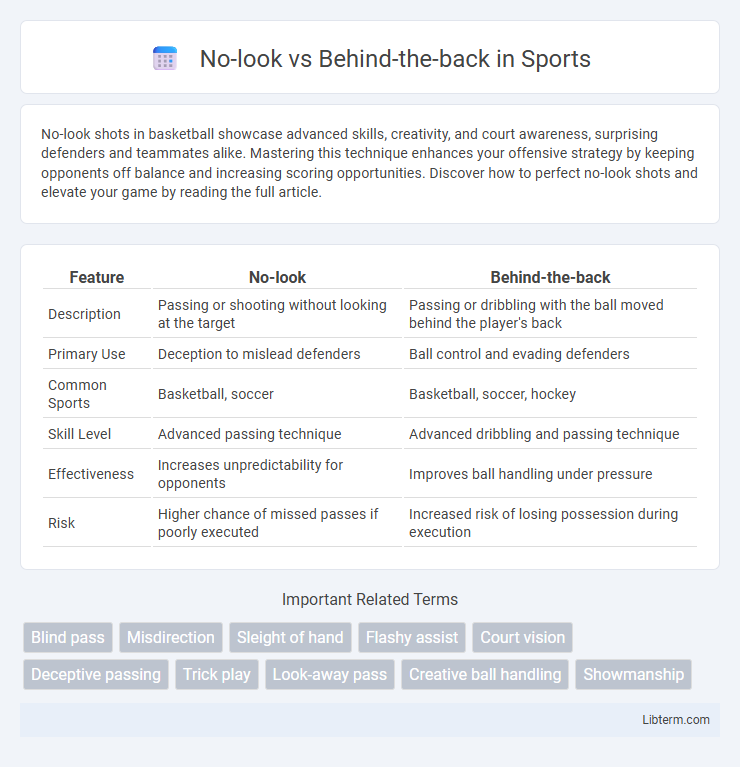No-look shots in basketball showcase advanced skills, creativity, and court awareness, surprising defenders and teammates alike. Mastering this technique enhances your offensive strategy by keeping opponents off balance and increasing scoring opportunities. Discover how to perfect no-look shots and elevate your game by reading the full article.
Table of Comparison
| Feature | No-look | Behind-the-back |
|---|---|---|
| Description | Passing or shooting without looking at the target | Passing or dribbling with the ball moved behind the player's back |
| Primary Use | Deception to mislead defenders | Ball control and evading defenders |
| Common Sports | Basketball, soccer | Basketball, soccer, hockey |
| Skill Level | Advanced passing technique | Advanced dribbling and passing technique |
| Effectiveness | Increases unpredictability for opponents | Improves ball handling under pressure |
| Risk | Higher chance of missed passes if poorly executed | Increased risk of losing possession during execution |
Introduction to No-look and Behind-the-back Moves
No-look and behind-the-back moves are essential techniques in basketball that enhance player deception and ball control. No-look passes involve directing the ball towards a teammate without visually confirming the target, creating unpredictability for defenders. Behind-the-back moves, including passes and dribbles, allow players to maintain ball protection while navigating tight defensive pressure and changing direction fluidly.
History and Evolution of Creative Passing
No-look and behind-the-back passes trace their origins to early basketball innovators in the mid-20th century, evolving as players sought to deceive defenders and elevate offensive creativity. Pioneers like Bob Cousy popularized no-look passing in the 1950s, while behind-the-back passes gained traction through streetball culture and NBA legends such as Pete Maravich and Magic Johnson. This evolution reflects a continual push towards unpredictable playmaking, making these passes essential tools for enhancing team dynamics and spectator excitement.
Key Differences: No-look vs Behind-the-back
No-look passes involve a player intentionally looking away from the teammate receiving the ball to deceive defenders, enhancing offensive unpredictability. Behind-the-back passes require the ball to be passed around the player's body, often used to protect the ball from defenders while maintaining control. The key difference lies in visual focus versus hand positioning, with no-look emphasizing gaze diversion and behind-the-back emphasizing ball handling technique.
Technical Breakdown of No-look Moves
No-look passes in basketball require precise spatial awareness and timing to deceive defenders while maintaining accurate ball control, relying on peripheral vision and split-second decision-making. These moves involve advanced hand-eye coordination and wrist flick techniques to control ball trajectory without visual confirmation. Unlike behind-the-back passes, which focus on ball protection by wrapping it around the body, no-look passes prioritize misdirection and anticipation to create scoring opportunities.
Mastering the Behind-the-back Pass
Mastering the behind-the-back pass enhances ball control and unpredictability, allowing players to shield the ball while maintaining offensive momentum. This technique requires precise hand-eye coordination, spatial awareness, and timing to effectively deceive defenders and create scoring opportunities. Developing fluid behind-the-back passes improves overall court vision and expands a player's tactical arsenal beyond typical no-look passing.
Situational Effectiveness in Real Games
No-look passes excel in situations requiring quick deception to mislead defenders and create space, especially in fast breaks and tight defensive pressure. Behind-the-back passes provide enhanced control when defenders closely guard the passer's dominant side, allowing for smoother ball transitions and safer distribution. Both techniques demand high skill levels but vary situationally: no-look passes thrive in unpredictable moments, while behind-the-back passes are more effective in maintaining possession under defensive pressure.
Impact on Team Dynamics and Offense
No-look passes enhance team dynamics by confusing defenders and increasing offensive unpredictability, leading to more scoring opportunities and fluid ball movement. Behind-the-back passes emphasize control and style, allowing players to navigate tight defenses while maintaining possession and setting up teammates effectively. Both techniques elevate offensive efficiency by creating space and disrupting defensive schemes, crucial for cohesive and dynamic team play.
Notable Players Famous for Each Move
Notable players famous for no-look passes include Magic Johnson and Steve Nash, who mastered the art of deceiving defenders with their precise court vision without looking at the target. Behind-the-back passes are famously associated with players like Jason Williams and John Stockton, known for their flashy yet effective ball handling and ability to thread the needle between defenders. Both moves require exceptional spatial awareness and creativity, solidifying these athletes as pioneers in basketball passing techniques.
Common Mistakes and How to Avoid Them
No-look and behind-the-back passes often have common mistakes such as poor ball control, inaccurate throws, and lack of situational awareness, which lead to turnovers and missed scoring opportunities. To avoid these errors, players should practice muscle memory drills to improve precision, maintain proper hand positioning, and enhance peripheral vision to anticipate teammates' movements. Consistent repetition and slow progression from stationary to game-speed exercises will build confidence and reduce the risk of flawed execution during competitive play.
Training Drills to Perfect Both Skills
Training drills to perfect no-look and behind-the-back passes focus on improving hand-eye coordination, spatial awareness, and ball control. Practicing repetitive passing sequences with dynamic targets enhances accuracy and timing, while incorporating resistance and movement drills builds confidence and fluidity under pressure. Combining cone drills, partner passing, and game-scenario simulations accelerates mastery of both skills for effective in-game execution.
No-look Infographic

 libterm.com
libterm.com